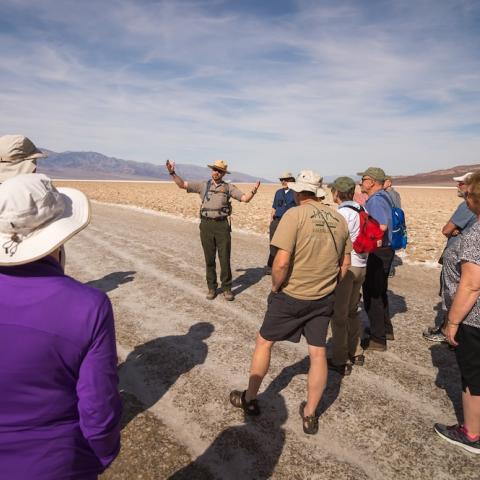
A sage thrasher perches on a shrub near Kelleys Well in Inyo County, California. The Mojave Desert's bird populations have been hit hard by climate change, but a new study shows that its small mammal populations are stable. Physiological modeling indicates that small mammals have much lower "cooling costs" than birds because of their ability to escape the sun in underground burrows, protecting them from the warming effect of climate change/Chelsea Hofmeier
Editor's note: The following story was constructed from a press release from the University of California, Berkeley.
Though birds presumably could fly to cooler temperatures as the climate heats up, studies show that burrowing animals in places such as Death Valley National Park and Mojave National Preserve in California are better able to endure higher temperatures than their feathered counterparts.
The bottom line, researchers say, is that species such as kangeroo rats, the white-tailed antelope squirrel, and the cactus mouse can rather easily cool off by heading down into their burrows, while birds don't have such naturally cooled environments to retreat to.
"Scientists tend to assume that most species in a region experience the same exposure to temperature or precipitation changes, and that they all respond in the same way. But we're finding now that animals have diverse strategies for reducing their exposure to hot and dry conditions that could kill them," said study senior author Steven Beissinger, a University of California, Berkeley, professor of environmental science, policy and management and a researcher at the campus's Museum of Vertebrate Zoology. "You should see these differences most strongly in a harsh environment like the desert, where life is really on the edge."
Looking at the Mojave Desert, an area in Southern California and Nevada that is home to Death Valley and Joshua Tree national parks and the Mojave National Preserve, the researchers found that as a whole, the desert has seen an approximate 3.6-degree Fahrenheit increase in average mean temperature and a 10-20 percent decrease in precipitation over the last century.
"Desert species have been thought to be relatively invulnerable to climate warming, but many desert species are already at or near their temperature and aridity tolerance limits. Each species also has different degrees of resilience," said study co-author Lori Hargrove, an ecologist at the San Diego Natural History Museum. "Climate change may seem minor, only a few degrees, but it has already had, and is having, direct and significant impacts on many species, each of which, in turn, affects other species, with cascading effects yet to be realized."
Eric Riddell, an assistant professor of ecology, evolution and organismal biology at Iowa State University who was the lead author on the study, said that, "(I)t's becoming clear that animals across the planet are responding to climate change by shifting where they live and shifting when they breed, and we're starting to get really strong evidence of population declines in certain areas that may be associated with warming. Some estimates now suggest that one in six species will be threatened by climate change over the next century. Figuring out which species those are, what kind of traits they have, will be critical."
Riddell created computer models to determine how various bird species were able to cope with heat in desert settings. He found that those species with the greatest "cooling costs" -- how much water, for example, they needed to cool their bodies -- were those most likely to suffer under warming tempatures and a drying climate. "Bird species’ declines were positively associated with climate-driven increases in water requirements for evaporative cooling and exacerbated by large body size, especially for species with animal-based diets," the researchers found in an earlier study.
"Thermal conductance is basically how quickly something transfers heat with its environment," Riddell said for the latest study. "A big, fluffy mammal might transfer heat very slowly, whereas an animal with very sparse or short fur, like a ground squirrel, might transfer heat quickly."
According to the computer models, cooling costs were, on average, about 3.3-fold higher for birds than they were for small mammals. Higher temperatures associated with climate change increased cooling costs by 58 percent for birds, but only 17 percent for mammals. This was largely due to the fact that the small mammals can retreat to underground burrows during the hottest parts of the day, the researchers said.
"A lot of the difference in cooling costs is related to what we call microhabitat differences. Small mammals are able to go underground where it is much cooler, and they're not being exposed to the direct sunlight, which heats up the bodies of the birds," Beissinger said. "These microgeographic variations in their exposure make a big difference, and these variations need to be considered when we think about how climate change will impact individual species."
To prevent further losses, Beissinger says it will be important to identify local refuges in the desert where species will be able to maintain themselves when temperatures soar. Reducing the demand on aquifers in the region may also prevent more desert springs from drying up, returning more water to the parched landscape.
"This study has made me realize just how complicated predicting the effects of climate change truly are," Riddell said. "It isn't just about where the landscape is warming and where it isn't warming. It's a really complex process that involves many aspects of an organism's biology, including their physiology, their behavior, their evolution -- it's all coupled. You need to take a really integrative approach to understand it."




 Support Essential Coverage of Essential Places
Support Essential Coverage of Essential Places






